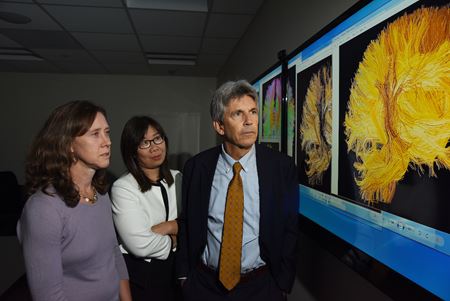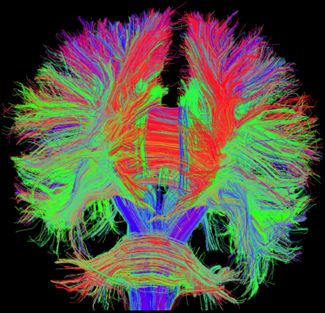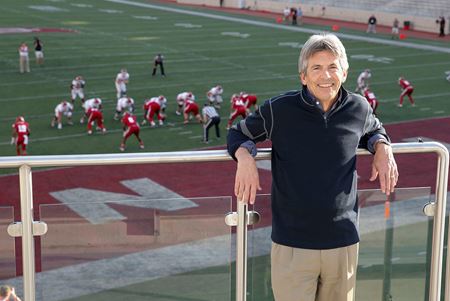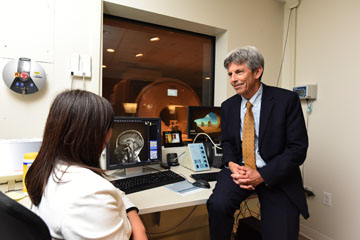New facts learned about long-term effects of mild traumatic brain injury
Concussions are a relatively common occurrence, especially among athletes. While many people write them off as minor events, the world’s largest concussion study is showing these mild traumatic brain injuries can have long-lasting impacts on brain health.
What’s more, similar blows to the head can affect individuals differently.
“It’s way more complicated than we thought,” said Thomas McAllister, MD, the Albert Eugene Sterne Professor of Psychiatry at Indiana University School of Medicine. He’s been studying the neurological effects of TBI — part of the school's expertise in neuroscience — for the last 30 years.
A leader in concussion research, McAllister is a principal investigator for the CARE Consortium, a global, multi-institutional study involving over 53,000 collegiate athletes and military cadets. In 2014, the U.S. Department of Defense (DOD) and the National Collegiate Athletic Association (NCAA) teamed up to take on concussion research, awarding a total of $105 million in grants over the last decade to research teams at IU School of Medicine, University of Michigan, the Medical College of Wisconsin and the Uniformed Services University/Henry Jackson Foundation. Led by McAllister, IU School of Medicine serves as the administrative and operations core for the study and is the central coordination center for the CARE Consortium.
“Mild brain injury was known as the signature wound of the war on terrorism,” McAllister said. “At the same time, there was a lot of publicity around the NFL and the discovery that people with multiple concussions could develop a progressive neurodegenerative disorder which became known as chronic traumatic encephalopathy, or CTE. That brought together civilian, military and societal interests, recognizing there could be a large public health issue with the number of people engaging in contact sports.”
 Now 10 years into the world’s largest longitudinal concussion study — involving 30 universities and military academies — CARE is producing a wealth of data on the neurobiology behind mild TBIs and the trajectory of personal recovery. IU School of Medicine plays a major role as the consortium's lead institution for neuroimaging, biostatistical analysis and biobanking of specimen samples.
Now 10 years into the world’s largest longitudinal concussion study — involving 30 universities and military academies — CARE is producing a wealth of data on the neurobiology behind mild TBIs and the trajectory of personal recovery. IU School of Medicine plays a major role as the consortium's lead institution for neuroimaging, biostatistical analysis and biobanking of specimen samples.
“We’ve had up to 300 people working at IU and across the partnering institutions — it’s really a team science initiative,” McAllister said. “At IU, we have probably 30 to 40 people who are partially supported by the CARE grant.”
Through advanced imaging techniques, researchers can see white matter changes in the brain immediately following an injury and can track those changes over time as symptoms improve.
“MRI technologies have advanced a lot since the CARE project was first launched,” said Yu-Chien Wu, MD, PhD, associate professor of radiology and imaging sciences at IU School of Medicine, who has worked in concussion research with McAllister for the past 14 years. “Now, MRI offers more accurate and higher-quality images to detect smaller and subtler changes in the brain.”
 The “holy grail of brain injury,” said McAllister, would be to develop a blood test to help determine concussion severity.
The “holy grail of brain injury,” said McAllister, would be to develop a blood test to help determine concussion severity.
“Some biomarkers do indeed show up in the blood within hours after concussion, and the amount you can measure in blood correlates with the severity of impact,” McAllister said of emerging research findings. “So, in the medical tent at the Super Bowl, you could have a point-of-care blood prick to measure output of a particular protein in the blood, adding confidence to the clinical evaluation.”
That could potentially help players and their coaches determine when it’s safe to return to the field. In the military, ongoing combat operations have produced a high rate of TBI and blast-related concussions, affecting not only individual servicemembers but also warfighter readiness.
“One of the stated goals for the current phase of the study is to create an algorithm to predict which people are at risk for prolonged symptoms or neurodegeneration and poor outcomes decades after injury,” McAllister said.
By tracking the injuries and symptoms of thousands of athletes and soldiers over time, CARE researchers are learning how to make more accurate prognoses. Of the original 53,000 participants, about 10% were diagnosed with a concussion during their four years of collegiate sports or military academy service. About 4,000 of those people underwent in-depth assessments upon graduation, and another 4,000 came back for extensive evaluations five years later, McAllister said.
“It’s a very rich data set,” he said. “We now have a longitudinal study that has followed some of the same people from their first year of college or military service up to 10 years post-graduation.”
Concussion myth busters
Researchers are learning that genetics can impact a person’s susceptibility to brain injury. An identical blow to the head can cause a concussion in one person and not in another, McAllister said. Other people may develop a concussion from repetitive small impacts rather than one major whack.
 In the third phase of the study, called the CARE SALTOS Integrated Study, or CSI, former collegiate athletes come to either the IU School of Medicine or the Medical College of Wisconsin for a full day or more of psychological and neurological exams, plus several types of brain scans.
In the third phase of the study, called the CARE SALTOS Integrated Study, or CSI, former collegiate athletes come to either the IU School of Medicine or the Medical College of Wisconsin for a full day or more of psychological and neurological exams, plus several types of brain scans.
“We now have people who have participated in the CSI study from all 50 states and 20 countries,” McAllister said. “We are literally flying people in from England, Africa and all over the world to come and be studied.”
These participants joined the study at the start of their collegiate experience, when baseline assessments were recorded before any head injuries occurred. Those who experienced concussions were assessed frequently in the weeks and months after injury. Researchers discovered 80% took up to four weeks to recover while the vast majority of the remaining 20% were able to return to play if given an additional month to recover.
“It’s a myth that you’re either immediately better in a few days or you have a horrible injury,” McAllister said. “We discovered a much more nuanced view of what ‘normal’ recovery looks like. This gives people more license to take their time to recover. It’s a positive message.”
 Athletes from all sports and genders were included in the study. Unsurprisingly, American football players have a significant risk of concussion. Six universities agreed to equip their players’ helmets with biomechanical sensors to measure the frequency and magnitude of impacts.
Athletes from all sports and genders were included in the study. Unsurprisingly, American football players have a significant risk of concussion. Six universities agreed to equip their players’ helmets with biomechanical sensors to measure the frequency and magnitude of impacts.
“It turns out, there are lots of people who get hit really hard, and some are diagnosed with a concussion while others are not diagnosed with a concussion,” McAllister noted. “Conversely, there are people who are not hit that hard, yet they are diagnosed with concussion and have complications from that. This suggests something else is going on in terms of biomechanics.”
Then there are the players who don’t take any big hits but become symptomatic days after the game or practice.
“They show up in the next few days in the training room saying, ‘I’m not feeing right,’ having headaches, disequilibrium and fuzzy thinking,” McAllister said. “You can’t tell, looking at game film, where was the hit where they were injured? People don’t have the same threshold for concussion.”
McAllister sees a day when genetic testing could help athletes and their parents determine personal risk-versus-benefit ratios for playing contact sports. It’s a question he’s often asked at social gatherings: “Should I let my kid play football?”
 Until there’s a blood test to measure predisposition to concussions, McAllister advises the “common sense” approach. Data shows that the more concussions someone has, the likelier they are to have repeat concussions of increasing severity.
Until there’s a blood test to measure predisposition to concussions, McAllister advises the “common sense” approach. Data shows that the more concussions someone has, the likelier they are to have repeat concussions of increasing severity.
“If you notice your child is getting injured more frequently and taking longer to recover, and if it’s taking less of an impact to cause the same injuries, those are signs you should take seriously,” he said. “Keep track of your child’s injuries because the number of lifetime diagnosed concussions may be associated with some longer term difficulties.”
The CARE Consortium will continue to seek evidence-based answers to those big questions about concussions.
“We have been able to publish 130 to 140 peer-reviewed publications on the findings from the consortium for the past 10 years,” McAllister said. “Now we’re taking a longer-term look at potential brain health effects of concussion and repetitive head impact exposure. The vision from the start, if sufficient interest and resources allow, was to make this the Framingham (heart) study of concussion and follow this cohort for 30 or 40 years, or more.”
